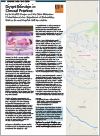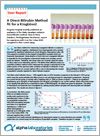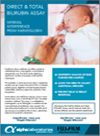Bilirubin Testing
Higher than normal levels of bilirubin
may indicate different types of liver or bile duct problems
Bilirubin is a waste product produced by the normal breakdown of haemoglobin in the blood and exists in two forms – indirect and direct bilirubin.
Indirect or unconjugated bilirubin circulates in the blood bound to albumin. When it reaches the liver it is converted into a water soluble form by conjugation with glucuronic acid. The direct or conjugated bilirubin is then secreted into the small intestine to allow its elimination from the body.
Typically, bilirubin levels fall somewhere between 0.3 and 1.2 milligrams per decilitre (mg/dL).
A bilirubin test is used to detect an increased level in the blood. It may be used to help determine the cause of jaundice and/or help diagnose conditions such as liver disease, hemolytic anemia, and blockage of the bile ducts.
Applications
Neonatal Hyperbilirubinaemia
Neonatal hyperbilirubinaemia is common in newborn babies as they lack the intestinal bacteria that help process bilirubin. Typically this resolves itself in a couple of days. However, in some instances, the hyperbilirubinaemia is a result of red blood cell destruction caused by newborn and maternal blood type incompatibilities, or other genetic factors. This can lead to elevated levels of total bilirubin, which has the potential to damage developing brain cells in young babiesif left untreated.
Whilst less common, hyperbilirubinaemia can also arise due to elevated levels of direct bilirubin which is indicative of neonatal cholestasis. This may be a result of biliary atresia requiring surgery to re-establish bile flow or liver transplant.
High levels of haemolysis are not uncommon in neonatal samples, which can make paediatric patients particularly vulnerable if the bilirubin assay used has low haemoglobin tolerance and samples get refused due to unsuitability for analysis.
This issue is eradicated with the Wako Vanadate Oxidation Method for Bilirubin measurement which is not affected by haemolysed samples.
Benefits
Confident Analysis of Even Haemolysed Samples
Traditional diazo methods are often subject to interference from haemoglobin. This creates a risk of reporting values below the true concentrations. Therefore laboratories may find themselves rejecting a significant number of samples which exhibit haemolysis.
This problem is most commonly seen in paediatric samples and can impact the care of this vulnerable patient group. Rejection of haemolysed samples necessitates additional specimen collection from the patient.
The Wako Direct Bilirubin assay is not significantly affected by haemolysis up to an index of 800: levels that are commonly seen in neonatal samples.
The use of this assay prevents rejection of samples as unsuitable for analysis and has been adopted by many laboratories.
Within the Wako Assays Bilirubin is oxidised to biliverdin and the change in absorbance as measured in the yellow part of the spectrum is used to calculate the bilirubin content of the sample.
Both Direct and Total Bilirubin assays provide excellent performance with minimal interference, delivering clear, reliable answers when it matters.
You can use them with confidence:

No interference from Ascorbic Acid up to 50mg/dL
No interference from Haemoglobin up to 500mg/dL
Direct Bilirubin: linear to 20mg/dL (342µmol/L)
Total Bilirubin: linear up to 40mg/dL (684µmol/L)
Ready-to-use liquid stable reagents
Open-vial stability 30 days at 2-8C
Standardised to SRM916a (NIST)
Case Studies
-

Direct Bilirubin in Clinical Practice
by Dr Manjit S Devgun and Mrs Claire Richardson Clinical Laboratories, Department of Biochemistry, Wishaw General Hospital, NHS LanarkshireDownload: 1.44MB -

A Direct Bilirubin Method fit for a King(ston)
Kingston Hospital evaluation of the Wako vanadate oxidation Direct Bilirubin method.Download: 10.80KB -

Bilirubin Assay User Reports in Leading Edge
South Devon Healthcare NHSFT and East Kent Hospitals University NHSFTDownload: 13.07 KB




